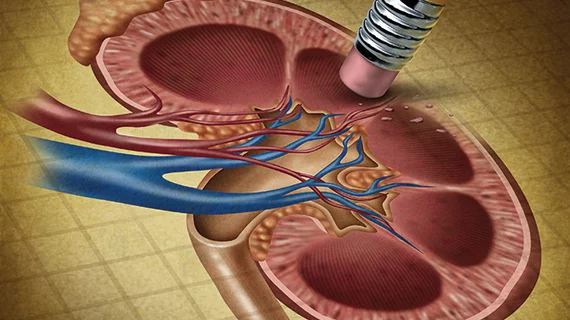AKI following LAAC ‘relatively frequent,’ tied to worse midterm outcomes
Acute kidney injury (AKI) occurs in about 9 percent of patients undergoing left atrial appendage closure (LAAC) and is associated with greater odds of downstream mortality and embolic events, according to a study published June 4 in JACC: Cardiovascular Interventions.
AKI has been identified as a common complication of percutaneous cardiac procedures, but this study is the first to evaluate its occurrence and impact on outcomes following LAAC—an increasingly popular alternative for stroke prevention in patients with nonvalvular atrial fibrillation and a high bleeding risk.
Lead author Luis Nombela-Franco, MD, PhD, and colleagues analyzed 355 patients undergoing LAAC at six centers in Spain and Canada. Among their findings:
- 9 percent of patients experienced AKI, defined as an absolute increase in serum creatinine of at least 0.3 mg/dl or a relative increase of at least 50 percent within 48 hours of the procedure.
- Poorer baseline renal function was the only independent predictor of AKI. Each 10 ml/min decrease in glomerular filtration rate (GFR) was associated with 32 percent higher odds of AKI.
- After a median follow-up of 18 months, patients in the AKI group were 2.59 times more likely to die, 6.14 times more likely to suffer ischemic stroke or systemic embolism and 2.36 times more likely to have a major bleeding event.
- More than half of patients with AKI experienced GFR deterioration of at least 25 percent during follow-up, compared to 17 percent of patients without AKI.
“The present study is the first to demonstrate that the development of AKI could serve as a marker of poor prognosis following LAAC, and our findings further extend knowledge about the prognostic implications of AKI in a different scenario in interventional cardiology,” Nombela-Franco et al. wrote. “Subsequently, these findings suggest the importance of assessing renal function following LAAC, as with other vascular procedures, to identify patients who develop AKI and require close monitoring during the post-procedural period.”
The researchers also said combined procedures—which take longer and typically require more contrast administration—should be avoided in patients with chronic kidney disease at baseline. Nine percent of the procedures in this study were performed in combination with another intervention such as atrial septal defect or patent foramen ovale closure.
Two recent PCI studies have also reported post-procedural AKI rates of approximately 10 percent, the authors noted, but TAVR studies were closer to 20 percent, possibly reflecting an older and sicker patient population.
“Mechanisms of AKI could not be established by the present study design, but this complication is likely to be multifactorial, including baseline characteristics predisposition, hemodynamic status, and procedural factors such as contrast media administration, microemboli associated with the device manipulation in the LAA, general anesthesia, procedural complications, or red blood cell transfusion,” Nombela-Franco and colleagues wrote.
“Most of these factors are general to percutaneous vascular procedures and not exclusive to LAAC, and as in other interventions, efforts should be made to avoid unstable situations, preventable blood transfusions, and catheter or device manipulations that prolong the procedure unnecessarily.”
The researchers suggested the guideline-recommended strategy of administering extra saline periprocedurally could be particularly useful in patients with low GFR.

